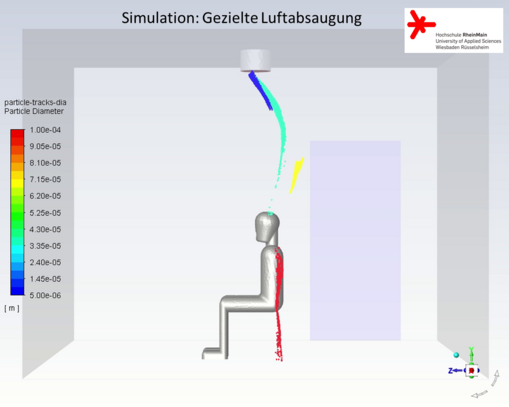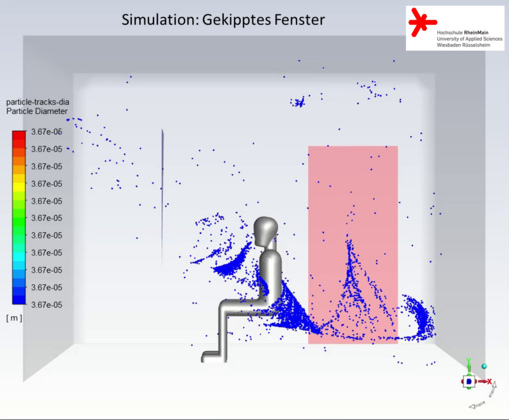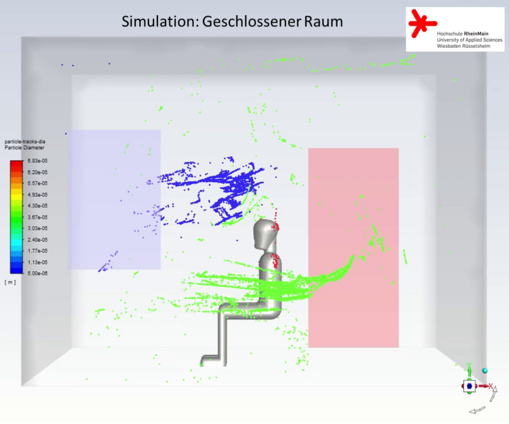COVID-19: Risk of infection
In the Faculty of Engineering at RheinMain University of Applied Sciences (HSRM), a simulation model was created that can be used to calculate, evaluate and analyze aerosol dispersion in rooms. The simulation model can be used to depict different situations, rooms, and layouts.
In closed rooms, the risk of contracting the SARS-CoV-2 coronavirus is high. Various studies show that the viral load is caused in particular by aerosols that are produced during exhalation, spread throughout the room, and circulate there for a long time. To reduce the risk of infection, these aerosols must be filtered out of the room air as quickly as possible. In order to evaluate suitable measures, appropriate methods of analysis are required that can both record and depict concrete situations and provide an insight into the way the measures work in the specific situations. Based on these results, general procedures can then be derived.
Dispersion of aerosols with no ventilation
In order to generate a basis for the evaluation of ventilation measures, researchers at HSRM first examined a room in which there was no ventilation whatsoever. A person exhaling aerosols was positioned in the room. The temperature of the air in the room was assumed to be 20°C, the temperature of the person in the room was assumed to be 36°C, and the exhaled air was likewise assumed to be 36°C.
“A slight convection current forms above the person in the direction of the ceiling due to his or her body temperature. We can see that the aerosols are affected by this convection current and spread chaotically in the room. While the larger exhaled droplets drop quickly to the floor, the smaller, lighter droplets remain in the air for a long time without accumulating on a surface,” explains Professor Werner Eißler. This demonstrates the now well-known danger of virus load in enclosed spaces.
Analysis of different ventilation measures
Two measures in particular have been discussed and implemented as remedies for aerosol loads: (a) ventilating the rooms by means of available windows and (b) filtering the room air with suitable devices. Measure (a) is inexpensive, but especially in the winter months it involves exposure to low temperatures for the people present in the room. Measure (b) depends on the suitability and availability of appropriate devices and is comparatively expensive as well as requiring high levels of maintenance.
In another simulation, the ventilation was examined with a slightly opened window and an open door on opposite sides of the room. A pressure difference of 0.2 mbar was assumed between the interior of the room and the environment outside the open window. This shows the effect of the ventilation compared to the situation in the closed room. The aerosols are caught up in the flow of the window ventilation and transported to the outside through the door. This results in a corresponding reduction in the air temperature in the room.
In a third test, the window was closed, and the room was ventilated by means of a conventional fan of the type used in rooms without windows or in kitchens. Again, for the purposes of the simulation, it was assumed that a door was open. “Here we see that the ventilation of the room results in a convection current, which, after a short time, catches the light aerosols and transports them out of the room through the fan. The heavy aerosols fall to the floor and remain there. Variations of the fan positions show that it is always effective, but the efficiency varies depending on the position of the fan. Compared to ventilation with a slightly opened window, however, extraction by means of a fan is the preferred method," says Professor Eißler.
Creation of a simulation model
This simulation model has created an evaluation tool that HSRM will use to further investigate and analyze the dispersion of aerosols in rooms. Investigations will also be carried out for more complex and larger rooms containing a larger number of people. It will also be possible to investigate the effect of filtering devices and how to position them in a way that achieves the best effect.
The research is funded by the Hessian Ministry of Higher Education, Research, Science, and the Arts (HMWK) in its program “Projects to improve the transfer of knowledge and technology” within the framework of the European Regional Development Fund, project number 20005852.


